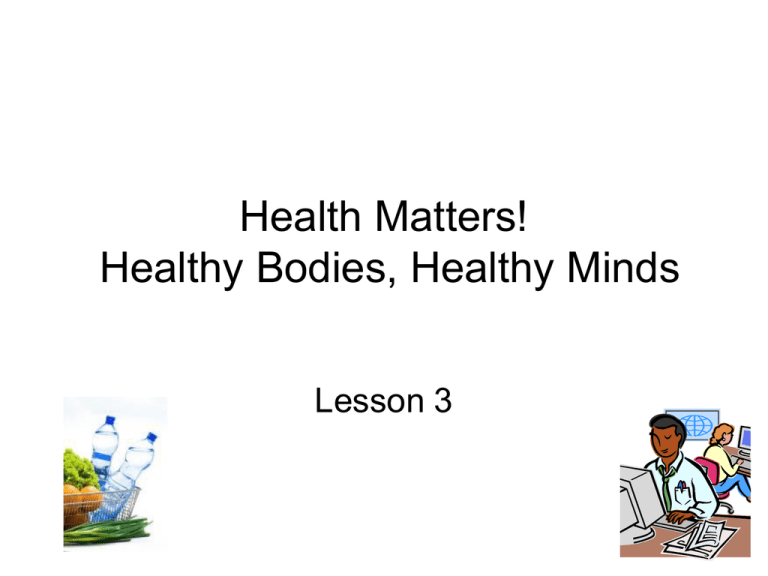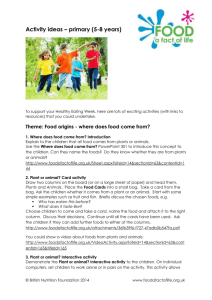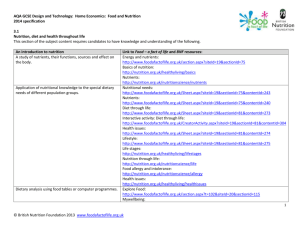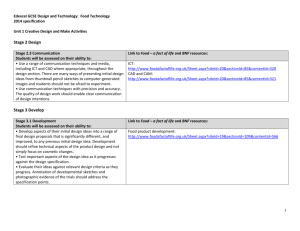Year 7 Health Matters - Healthy Bodies Healthy Minds
advertisement

Health Matters! Healthy Bodies, Healthy Minds Lesson 3 Obesity Slides from www.foodafactoflife.org.uk Extension Body weight Body weight is determined by energy intake from food and energy output, i.e. energy needed for basic body processes (such as keeping the heart beating) and for physical activity. If a person regularly takes in even a little more energy from their diet than they need, they will start to gain weight and eventually become overweight. Carrying too much extra weight as fat may impair health www.foodafactoflife.org.uk Obesity around the world The World Health Organisation (WHO) projected in 2005 that there were approximately 1.6 billion overweight adults (age +15) and 400 million obese adults. WHO estimated at least 20 million children under the age of 5 years were overweight in 2005. www.foodafactoflife.org.uk Obesity in Britain Over the last 25 years the number of adults who are obese is almost four times as great. Two thirds of UK adults are now considered overweight. Of these, 22% of men and 23% of women are considered obese. www.foodafactoflife.org.uk Fat storage It is normal to store fat during growth, particularly during infancy and adolescence. It is therefore difficult to measure obesity in children. The NHS data (2005) shows the number of obese children has tripled over the last 20 years. At least 10% of six-yearolds and 17% of 15-year-olds are now obese. Childhood obesity is a strong indication that the child will be obese as an adult and is likely to lead to health risks in later life. www.foodafactoflife.org.uk Health problems associated with obesity People who are obese are more likely to suffer from: • coronary heart disease; • type 2 diabetes; • gall stones; • arthritis; • high blood pressure; • some types of cancers, i.e. colon, breast, kidney and stomach. www.foodafactoflife.org.uk Health issues and weight loss Most of the health problems associated with obesity decrease through weight loss. People who are very overweight find it more difficult to be physically active and this may add to their health problems. www.foodafactoflife.org.uk The role of physical activity Many people in the UK have very inactive lifestyles – few people have physically active jobs or participate in significant amounts of physical activity out of work. Lack of activity is an important factor in the increasing incidence of obesity. Walking or cycling instead of using a car, going to exercise classes and taking part in team sports such as football can all help a person maintain a healthy body weight by increasing energy output. www.foodafactoflife.org.uk The role of food All diets containing more energy than a person needs can cause weight gain. Fat provides just over twice as much energy per gram (37kJ/g) as carbohydrate (16kJ/g). It is recommended that: • about 50% of our energy intake should come from carbohydrate. • no more than 35% of our energy intake should come from fat. • about 15% of our energy intake should come from protein. www.foodafactoflife.org.uk A lifestyle change After a person discovers they are overweight or obese their lifestyle will need to change to reduce weight. Many factors lead to a person becoming overweight or obese. Doctors or dietitians can provide information on lifestyle changes that can lead to weight loss. This can be a good opportunity to make general improvements to their diet and physical activity levels. www.foodafactoflife.org.uk Childhood obesity Children who are very obese are not put on specific slimming diets. Guidelines to help children maintain a healthy weight include: • 60 minutes of physical activity each day; • at least 5 portions of fruit or vegetables a day; • eat less fat; • child sized portions of food at each meal; • swap high sugar food and drinks to low sugar alternatives. www.foodafactoflife.org.uk Overweight but not obese Being overweight (BMI 25-30), but not obese, is still a risk to health. People in this range should not gain anymore weight and ensure they participate in physical activity and eat a balanced diet to become a healthy weight. In many countries, there are cultural pressures for people, especially women, to be slim. People may try to lose weight even though they are in the normal weight range for their height or only slightly overweight. Severe weight loss may lead to development of an eating disorder, e.g. anorexia nervosa or bulimia. www.foodafactoflife.org.uk Measuring body weight Comparing weight relative to height is a quick and easy way of finding out if someone is a healthy weight for their height. A useful way to judge if a person is overweight or obese is to calculate their body mass index (BMI). BMI should only be used for adults, i.e. after 18 years of age when growth has stopped. www.foodafactoflife.org.uk kg . Body mass index 2 m BMI is worked out by: weight (kg) height (m) x height (m) The BMI can be compared with the following ranges: Recommended BMI range Underweight less than 18.5 Normal 18.5 - less than 25 Overweight 25 - less than 30 Obese 30 - 40 Very obese over 40 www.foodafactoflife.org.uk • In our first lesson you were asked to give Joy advice as she was unhappy with her body and wished she looked like the people she saw in her magazine. • Joy has been looking at ways to make herself thinner and has been on a diet that restricts the amount of calories she eats a day. Within a few weeks she lost some weight but now her mum is worried that she is getting too thin. Her mum has given her some information on eating disorders and asked • After reading the information that her mother has given her Joy has decided to check her weight to see if she is in the healthy range. • Joy weighs 9 stone and is 5’5. Look at the chart and see if she is in the healthy zone. • People who are anorexic are addicted to losing weight, dieting and sometimes excessive exercising. • Anorexics usually keep their excessive dieting a secret and sometimes wear baggy clothes to hide their weight loss. • Anorexia is a dangerous illness as reducing the amount of food you eat puts parts of your body, especially your heart under lots of strain, and can be life threatening. • Many anorexics find that their hair is limp and lifeless and may fall out as they are lacking in vitamins. • Skin may become pale and look dull. • They will often be tired as they are not getting enough energy to lead a healthy lifestyle. • Like anorexia bulimia is an illness relating to weight loss. • People with bulimia may eat lots of high calorie food such as cake and chocolate but then make themselves sick after eating it. • The side effects of this illness are limp hair, bad nails, bad teeth as the stomach acids when you are sick makes teeth rot. • More serious side effects can in serious cases include heart problems. This is caused by the strain on the heart by not getting enough energy to keep it working properly. • Bulimia can also be life- threatening. • As part of your final magazine, design a fact file on eating disorders and keeping healthy. • It will need to include information about – What are eating disorders? – Why might they occur? – Symptoms – Where to get help Fact file- Eating disorders Example format What? Why does it happen How to get help Symptoms How to support a friend











